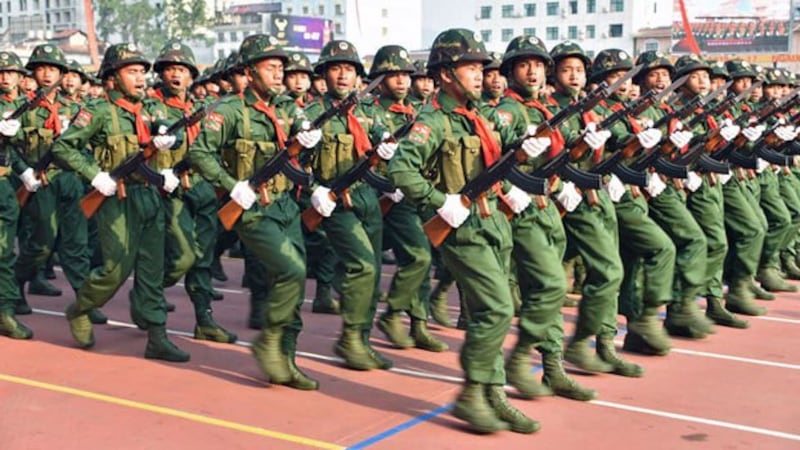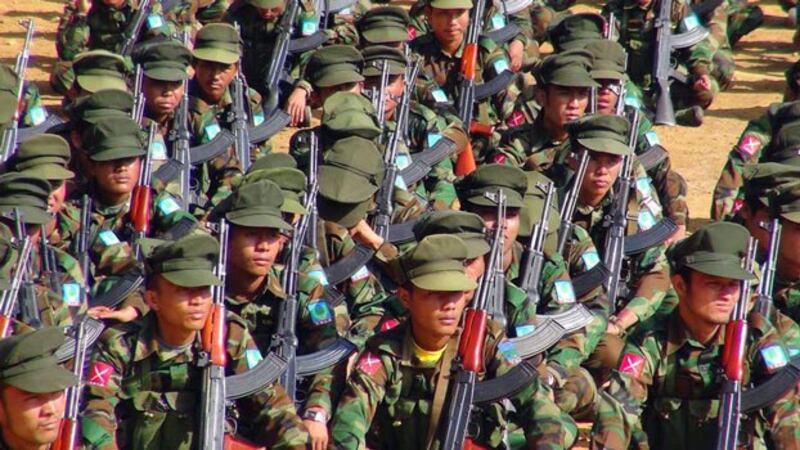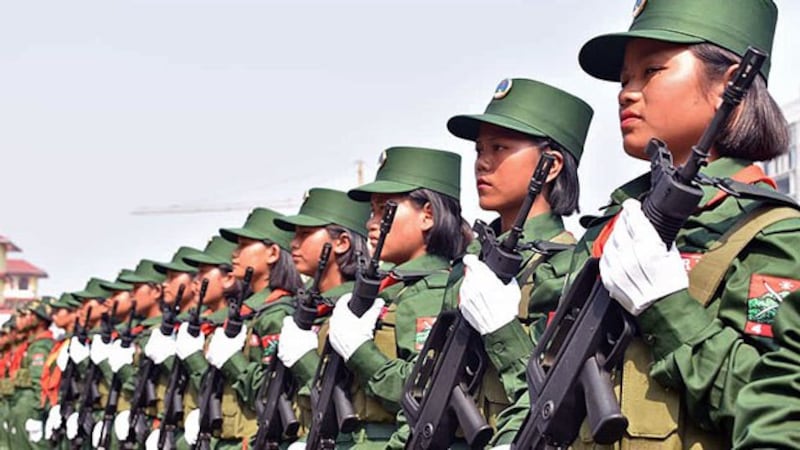Myanmar’s most powerful ethnic armed groups, which remain outside national leader Aung San Suu Kyi’s slow-moving peace talks, have set up full-blown military service academies in their territories, with some training cadets from other rebel militias to face a common foe, the government military.
The ethnic armies describe the academies as a way to professionalize their ranks and boost their bargaining positions in any future peace talks with the government.
But the Myanmar military says the academies run by rebel armies infringe on national sovereignty.
In a country that’s been at war since its independence in 1948, the ranks of ethnic armies in Myanmar total more than one-fifth of the 400,000-strong national military.
On Sept. 11, the United Wa State Army (UWSA), Myanmar most powerful ethnic army with 30,000 regular fighters, opened a four-year military service academy in far eastern Shan state on the border with China’s Yunnan province.
The new military school in Roung Tain village of Pangsang (Pangkham) town opened with an initial cohort of 100 cadets, a UWSA spokesman told RFA on Thursday.
“This is the first military academy school in our Wa state,” said Nyi Rang, the communications officer at the UWSA’s liaison office in Lashio. The school was set up to teach skills to future military leaders, he said.
“The goal for opening this school is to advance the technologies and skills of our troops to keep abreast of the changing trends,” the spokesman said, adding that the specific curriculum is classified.
Shan, Myanmar’s largest state and home to the country’s second-largest ethnic group, has been under armed conflict between government forces and numerous ethnic-based armies fighting for autonomy since 1958, 10 years after the former Burma gained independence from Britain in 1948.
Formed from members of the former Communist Party of Burma following the group’s disbandment in 1989, the UWSA has 10,000 auxiliary members in addition to its regular force and maintains close relations with China.
Myanmar’s constitution’s grants the roughly 500,000 Wa the right to administer what is known as Special Region 2, comprising the six townships of Hopang, Mongmao, Pangwaun, Matman, Namphan, and Pangsang in northern and eastern Shan state.
Although the UWSA has not fought against government forces for decades, its military strength, boosted by Chinese arms, makes it the most powerful force behind a cluster of ethnic armies that have resisted Myanmar leader Aung San Suu Kyi’s peace negations aimed at ending the country’s multiple wars and building a democratic federal union of the multiethnic nation of 54 million.

Four rounds of talks
Aung San Suu Kyi’s government has held four rounds of talks with about half of the country’s ethnic armies, mostly the smaller groups, without major breakthroughs.
The last round before Nov. 8 national elections was held in August and produced acceptance in principle by Myanmar’s powerful military of the concept of federalism after decades of resistance to the idea.
But the agreement was thin on concrete achievements and remained stuck on a key military demand — that the UWSA and its allies who have so far refused to sign Myanmar’s nationwide cease-fire agreement (NCA) must lay down their arms and enter the cease-fire pact. The NCA has been signed by 10 ethnic armed organizations since October 2015.
The UWSA is one of seven non-signatory groups that comprise the Federal Political Negotiation and Consultative Committee (FPNCC), an alliance of some of the largest of rebel armies that have been at war with the central government for decades and have resisted signing the NCA because they want to keep their armies.
The FPNCC has proposed a confederate system in Myanmar that allows ethnic organizations to maintain their own armed forces — a move that the Myanmar military strongly opposes.
When asked about the UWSA’s academy, a Myanmar military spokesman Major General Zaw Min Tun said that a sovereign nation can have only one military institution, repeating the armed forces’ long-held stance in peace negotiations that there should only be a single national military to defend and protect the state.
“With regards to that issue, there is one and only one military force in every sovereign country that was created for safeguarding and defending the state,” he said.
Zaw Min Tun also called on stakeholders involved in Myanmar’s peace process to work towards securing a lasting cessation of hostilities through the NCA.
The Myanmar military has said that it is trying to tolerate the UWSA after the ethnic army showed off its forces in an April 2019 ceremony marking the 30th anniversary of its founding.
At that time, Zhao Guo-ann, the UWSA’s vice chairman and external affairs officer, spoke of an expanded ethnic force at a news conference in Pangsang.
“We understand having one military institution under a sovereign nation, but with the current situation we are building up the UWSA’s military power in order to secure the political guarantee for the Wa people,” he said.
“Building up military power is just for the defense of the Wa people and not to rebel against the government,” he added, but cautioned that “everyone becomes a soldier if there is a military provocation or invasion.”

Allied training efforts
Political activist and writer Than Soe Naing said the UWSA’s new military academy was not intended to expand its forces, but rather to restructure them.
“Wa’s troops had been transformed from former Burmese Communist Party forces, so they didn’t have rankings like lieutenant or major,” he told RFA. “They have had only commanding officers for squadrons, [but] now they have established new rankings.”
Meanwhile the Ta’ang National Liberation Army (TNLA), another NCA non-signatory, held a graduation ceremony on July 23 for the first group of students from its military training school in northern Shan state.
More than 50 of the 70 cadets attending the academy graduated, said TNLA spokesman Mei Eik Kyaw.
“We sometimes request legal, military and political experts from our allied groups,” he said about the training facility. “We have our own coursework as well as lectures by outside groups.”
The TNLA also sometimes sends students to study at the military service academy run by the Kachin Independence Army (KIA), he added.
The TNLA along with the KIA, Arakan Army (AA), and Myanmar National Democratic Alliance Army (MNDAA), also known as the Kokang Army, form the Northern Alliance, a sub-grouping of ethnic militaries that have not signed the NCA.
Earlier this year, the AA, which is fighting for greater autonomy for ethnic Rakhine people in their western coastal state, was declared an illegal association and terrorist organization by the Myanmar government.
Mei Eik Kyaw pointed out that the AA started out with only 26 privates in 2009, but now has more than 7,000 soldiers, some of whom initially trained at the KIA’s facility.
In 2010, the AA began instructing soldiers at its own training school in Laiza, and have turned out 50 co-ed cohorts with approximately 500 cadets in each unit, he said.
AA spokesperson Khine Thukha declined to provide information about the training program when contacted by RFA, saying it was classified.

Raising their game
The Mon National Liberation Army (MNLA), whose political wing, the New Mon State Party (NMSP), is an NCA signatory, also operates a cadet training center.
NMSP spokesman Naing Aung Ma Ngay said having a military academy gives ethnic armies a leg up when negotiating with Myanmar forces for a peace deal.
Ethnic armies “plant the seeds of military discipline in training schools, though they need to be careful not to overemphasize their military strength,” he told RFA.
The KIA, which was formed in 1961, has operated a military academy at its headquarters in Lashio, northern Shan state, since 2000 and has provided training to soldiers from other ethnic armies.
In late 2014, the academy was attacked with heavy artillery, killing 23 students from various ethnic groups who were undergoing military training.
KIA spokesman Colonel Naw Bu said the facility accepts college graduates and young people who have completed high school as a minimum qualification.
“We also accept girls as students. We accept young people with a revolutionary spirit,” he said.
Cohorts of 50-60 students take three years to complete the KIA’s basic military training program, which consists in part of physical exercises, military-related procedures, and light weaponry training, he said.
“We previously trained the privates from other ethnic armed groups, but now there are almost no students from other groups,” Naw Bu said.
The All Burma Students' Democratic Front (ABSDF), founded in 1988 by former student exiles, also has military training facilities and other instructional programs. The ethnic army is a signatory of the NCA.
“We have joint training programs with allied groups,” said ABSDF spokesman Private Myo Win said. “We also have separate trainings.”
The selection criteria for students are based on their education level and experience similar to that of other ethnic armies, he said without elaborating.
The Restoration Council of Shan State/Shan State Army-South (RCSS-SSA), an NCA signatory group in northern Shan state that has engaged in sporadic clashes with Myanmar forces this year despite the cease-fire, does not have its own military service academy, but offers basic military skills training, said spokesman Lieutenant Colonel Ohm Khay.
“We don’t have any requirements for students who want to complete the training,” he said. “We provide training to [those] who have never had basic military training.”
Former Burmese Communist Party member Maung Maung Soe, who is now an analyst of ethnic and military affairs, said it is necessary for the ethnic armies to have training academies.
“If you are operating an armed group, you need to have basic military training usually up to the officer level,” he said.
“As long as the government cannot resolve the ethnic armed groups issue, these forces will continue their recruitment and training,” he added.
Reported by Aung Theinkha and Nay Myo Htun for RFA’s Myanmar Service. Translated by Ye Kaung Myint Maung. Written in English by Roseanne Gerin.
